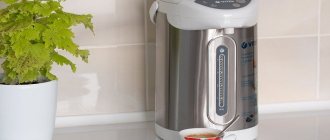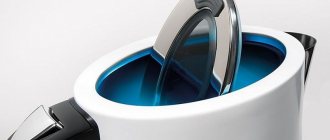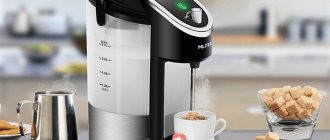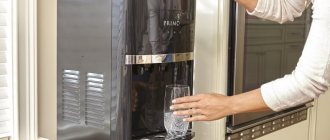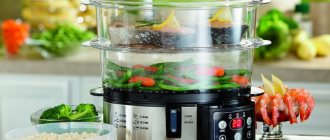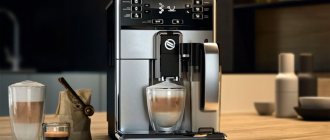What is the difference between a thermopot and an electric kettle?
To understand the main differences, pay attention to the parameters. You need to understand how each device works, what the main design and functional features are.
How the devices work
It would be better to take an electric kettle first for review, since it is the most common and is found in the kitchen of almost every housewife. The electrical appliance is connected to the network with a cord. The container is filled with water through the open lid. After turning on the button, which is usually located on the handle, current flows to the heating element. The heating element heats up to a high temperature and boils the water.
Important! All modern kettles are equipped with a thermostat that turns off the heating element after the water boils.
After turning off the heating element, the temperature of the water inside the kettle is not maintained by anything. The heating element does not turn on again. The water begins to gradually cool down. The cooling rate depends on the ambient temperature. Since the walls of the kettle are thin, after about 30 minutes the boiling water will turn into hot water.
After the water boils, the heating element turns off automatically and does not turn it on again.
The main difference between a thermopot and an electric kettle in terms of operation is that the household appliance performs two functions. A person receives a kettle and a thermos at the same time. Water is heated in the same way from a working heating element, but this takes longer, since a thermopot has a larger reservoir volume compared to a kettle. However, cooling also takes longer. In 2-3 hours the temperature drops by 20-30 °C. You can brew tea with hot water at 80-70 oC.
Depending on the volume of the tank, boiling water lasts 15-30 minutes. There are models with an additional heating element. In a thermopot, it maintains the heating of the liquid to a predetermined temperature. Water is supplied by a pump, which can be manual or automatic.
The thermopot heats water and maintains its temperature using the principle of a thermos
Design Features
Externally, the thermopot versus the kettle differs in size. A household appliance is considered stationary. The reservoir holds up to 8 liters of water.
The kettle is a mobile household appliance. It is equipped with a small tank with a capacity of 0.5 to 3 liters. The most popular teapots have a volume of 1.5-2 liters.
Important! There are many more varieties of kettles than thermopots. They are made from plastic, stainless steel, glass, and ceramics. They give it an interesting shape and are equipped with viewing windows and lighting.
Other features include the following:
- The kettle has one water tank, and some thermopot models have two. In the second container, the heating of the liquid is regulated. You can draw water at the desired temperature from the device.
The second tank maintains the set water temperature - The kettle only needs electricity until the water boils. Then you can remove it from the socket. If the thermopot is equipped with an additional heating element and an automatic pump, a constant connection to the outlet is required to maintain the temperature of the liquid. However, there are models with a manual pump and without an additional heater. They do not require a permanent connection to an outlet. The water temperature is maintained by the heat-resistant thick walls of the tank. In other words, they reduce the rate at which it cools.
- Usually all thermopots have a water filter. When it gets dirty, it is changed. For a kettle, the filter can only be a mesh mounted on the spout. It traps scale when pouring water into a cup.
Regardless of the material used, the body of the kettle is thin. It warms up along with the water. Touching may cause burns. The big advantage of a thermopot over a kettle is its thick, heat-resistant walls. Even when the liquid is boiling, they do not become hot. The possibility of injury from touching with a naked body is excluded.
Functional Features
The third important feature is the difference in functions. For a kettle, depending on the model, they are as follows:
- timer;
- protection against accidental activation by children or in the absence of water;
- automatic shutdown, for which the thermostat is responsible.
Advanced models are equipped with a clock. There is an alarm function and remote control from a smartphone. Budget electrical appliances have only a thermostat and a start button with an indicator light.
The modes of some devices can be displayed on an electronic display
If you look at ease of use, which is more profitable than a thermopot or an electric kettle, then the first electrical appliance has more functions. Even the budget model is equipped with a thermostat with 3-4 modes. Traditionally, there is a lock against accidental activation by children and without water. Depending on the model, there is a heating function, single serving dosage, and operating mode indicators. Rollover protection is considered useful. The automation locks the lid, preventing boiling water from spilling out of the tank.
Amount of energy consumed
Let's calculate the electricity consumed by a thermopot and a regular kettle.
- An ordinary kettle. If we take as a basis that the average kettle has a power of 2500 kilowatts, and the boiling time of water is 3 minutes, with 4 times of use per day we get the following consumption: kW/month = 2.5 * (3 * 4/60) * 30 = 15 kW /month. The resulting value is average. It may vary depending on the frequency of use and power of the electrical appliance.
- Thermopot. Let's assume that the power of the device is 800 W. Average boiling time with a volume of 4 liters. – 12 minutes. The device operates in temperature maintenance mode (90 degrees) daily for 10 hours. Average energy consumption for maintenance is 30 W. Let's make the calculation: kW/month=0.8*0.2*30+10*0.03*30=13.8
As you can see, energy consumption strongly depends on how often you use both normal heating and temperature maintenance mode.
At these values the difference is 1.2 kW, which is a small value.
So, the amount of energy per month that a thermopot consumes depends entirely on the power of the device and the frequency of its use. Conclusion: since many performance indicators in reality will differ greatly from those given, the choice of a device for heating water should be based solely on personal needs and preferences.
Which is better - a thermopot or a kettle?
Continuing to compare household appliances, you can consider their pros and cons. They are not the main factor in identifying differences, but help the consumer more accurately determine the choice of the appropriate device.
Arguments in favor of the kettle:
- fast water heating;
- compact size, light weight;
- mobility;
- a wide range of models of different designs;
- affordable price for all categories of the population.
Compactness, mobility and fast heating are considered the main advantages of an electrical appliance.
The disadvantage is the inability to heat a large volume of water at one time. Most cheap models have a short service life and a plastic body. When heated, it emits a toxic odor. Fast heating is not only a plus, but also a minus. A lot of electricity is consumed, and the old wiring cannot withstand the heavy load.
Arguments in favor of thermopot:
- maintains the set water temperature or slows down the cooling process due to heat-resistant walls;
- large tank up to 8 l;
- slow heating does not require high voltage, thereby reducing the load on electrical wiring;
- availability of convenient functions;
- To draw water, you do not need to turn the entire device over, but simply bring the cup to the spout.
The cost of even a budget thermal sweater will seem high for many buyers.
The disadvantage is the large size. It is impossible to heat water quickly.
What is better to buy a thermopot or an electric kettle according to consumer reviews and expert opinion?
All important criteria, taking into account the opinion of experts, are reflected in the comparative table.
| Comparison table of devices | ||
| Criterion | Kettle | Thermopot |
| Principle of operation | Boiling water | Boiling water Keeping temperature |
| Energy consumption/day | 1 kW (subject to repeated use) | 0.64 kW (including water heating) |
| Water heating time | 2-3 minutes | 20-30 minutes |
| Volumes | 2 liters | 2.5 – 8 liters |
| Power | 1500 – 3000 W | 700 – 800 W |
| Design and functional features | Loses temperature after boiling | Maintains temperature for a long time |
| Purposes of use | Single boiling | Constant access to boiling water |
| Price | From 1000 rub. | From 10,000 rub. |
Reviews from those who already use smart technology will help you determine which is better, more economical, and take into account the pros and cons of each. For a large family with children, the choice will be in favor of a thermopot. This is also a great option for the office. If there is no constant need for hot water, an electric kettle is quite suitable. In a small kitchen it is also more rational to use a compact kettle.
(No ratings yet)
You may also be interested in
- What is better, an iron or a steam generator for the home? Let's compare...
- Which kettle is better, enameled or stainless...
- Which sole is better to choose an iron with? Let's compare...
- What is better washing powder or washing gel?
- Which bed linen is better, poplin or satin?
- Is it better to wash with powder or capsules?
- What does the spin class mean in a washing machine and...
- What does washing machine wash class mean and...
- 12 simple tips on how to choose the right thermostat...
- How a thermopot works: operating principle and instructions...
- Instructions: how to descale a thermopot in...
- Instructions: how to choose the right electric...
Which is more economical: a thermopot or an electric kettle?
To understand the efficiency of devices, you need to find out which of them consumes little electricity. The thermopot wins here. In terms of instantaneous energy consumption, the device is more economical, since it is equipped with a less powerful heating element. He heats the water slowly at a time, and then only maintains its temperature.
Due to the low-power heater, the device consumes less electricity
Heating consumes up to 30 W/hour of electricity. In 10 hours the figure will be 300 W. To this value is added the flow rate spent on the initial heating of the liquid. For most household models, the figure is 200 W. In total, in 10 hours the consumption will be 500 W. It turns out that the electricity consumption of a thermopot compared to a kettle is negligible if both devices are constantly used for the specified time. When there is no heating function at all, the consumption is calculated using only one primary heating, that is, 200W.
Important! There are models with a heater with a power of up to 1.6 kW, which cannot be called economical.
What to look for when choosing
When choosing a new device, you should pay attention to the following:
- flask volume,
- power,
- presence of a hand pump,
- presence of a display.
The volume of such devices can vary from 3 to 5 liters. Depending on your needs, you should choose a device with the optimal ratio of volume and power. The rate of water heating will depend on these factors.
Having a manual pump will help you get hot water from the thermopot even in the absence of electricity. This is relevant for people living in areas with unstable electrical power. The digital display simplifies the setup process, making the interface intuitive and understandable.
What consumes more electricity: a kettle or a thermopot?
The leader in instantly consuming large amounts of electricity is the kettle. All models are equipped with a powerful heating element. The parameter usually varies from 1.7 to 2 kW. However, small amounts of liquid heat up quickly. Further temperature maintenance is not provided. Since the device initially consumes more electricity, but the water heats up faster, the approximate consumption for one boiling of 1.5 liters of liquid will be 140 W.
When turned on, the device consumes a lot of electricity once due to the powerful heater
The total consumption for the same 10 hours depends on the number of boils. On average, a family of four needs to heat water up to 6 times a day. If you take an electrical appliance with a 1.5 liter tank and a power of 1.7 kW, then the consumption will be 800 W.
Amount of energy consumed
Let's calculate the electricity consumed by a thermopot and a regular kettle.
- An ordinary kettle. If we take as a basis that the average kettle has a power of 2500 kilowatts, and the boiling time of water is 3 minutes, with 4 times of use per day we get the following consumption: kW/month = 2.5 * (3 * 4/60) * 30 = 15 kW /month. The resulting value is average. It may vary depending on the frequency of use and power of the electrical appliance.
- Thermopot. Let's assume that the power of the device is 800 W. Average boiling time with a volume of 4 liters. – 12 minutes. The device operates in temperature maintenance mode (90 degrees) daily for 10 hours. Average energy consumption for maintenance is 30 W. Let's make the calculation: kW/month=0.8*0.2*30+10*0.03*30=13.8
As you can see, energy consumption strongly depends on how often you use both normal heating and temperature maintenance mode.
At these values the difference is 1.2 kW, which is a small value.
So, the amount of energy per month that a thermopot consumes depends entirely on the power of the device and the frequency of its use. Conclusion: since many performance indicators in reality will differ greatly from those given, the choice of a device for heating water should be based solely on personal needs and preferences.
Boiling time of water in thermopot
How to choose a thermopot
A thermopot is a cross between an electric kettle, a thermos and a samovar. Its main function is similar to a kettle - boiling water; to a thermos - the ability to keep water hot; to a samovar - a method of pouring water without lifting the tank. More than twenty years ago, this miracle of technology was invented in Japan, but it is impossible to find a device for preparing hot drinks more suitable for Russian cultural and everyday realities.
If you compare a thermopot with a kettle, then, on the one hand, it heats the water more slowly, and on the other hand, it never lets it cool down, which a kettle cannot do. This is very useful for saving energy for those who have the habit of boiling water in a kettle, but not using it hot. The samovar is undoubtedly the most soulful and beautiful device for heating water, but from a practical point of view, a thermopot has a greater number of functions and their thoughtful execution, and accordingly, it satisfies the needs of a modern person much better.
Principle of operation
To use a thermopot, open the lid, pour water into it, after which it boils it and maintains the temperature at a certain level - specified by the user or set by default. After boiling, you can pour water into a mug or wherever needed. The thermopot's spout is on top, so a pump is used to supply it with water from the reservoir. Typically, a thermopot is equipped with two types of pumps at the same time - manual (pump platform on the sweat cover) and electric.
Volume
In terms of water tank volume, thermopots are larger than teapots, but smaller than samovars. Thus, the smallest thermal pots hold from 1.5 to 3 liters, they are suitable for families of up to three people. A thermopot of this volume is quite compact and fits well into a small kitchen. Medium-sized thermal pots - from 3.2 to 4.5 liters - are suitable for large families, as well as those who use a lot of hot water for other reasons. There are also thermal pots that hold 5-6 liters of water; they are convenient to use in the country or during family holidays. Devices of even larger volume are intended more for public catering outlets.
Power
To maintain a certain water temperature, thermopots still require a small amount of electricity, which distinguishes them from thermoses, however, they can maintain it indefinitely. To boil water, the maximum power of the device is used, and to maintain the temperature, the power is approximately ten times less. For different models, both parameters may be very different, so you should check them before purchasing. Thermopots with high power (from 900 W) and low consumption in maintenance mode are considered more effective. Thermopots with lower power (from 500 to 900 W) will boil water more slowly.
Housing material
The material of the thermopot body affects two aspects - aesthetic and practical. The metal body of the thermopot is less susceptible to mechanical damage, the outer surface is less abraded during cleaning, and if the body is not painted, it has a natural metal color. A plastic case will not withstand significant mechanical stress, its surface may change its appearance due to careless maintenance, but from an aesthetic point of view it is in no way inferior to a metal one. Whatever material the body of the device is made of, it should under no circumstances become very hot during operation of the thermopot.
Design
The appearance of thermopots varies significantly from traditional cylindrical cases with visors of control panels and Gzhel painting to futuristic chopped or streamlined shapes in monochrome. When choosing according to this parameter, they do not look for comrades.
The main colors of thermopots are usually white, black, grey, silver and beige, but you can also find thermopots in other colors.
Design features
Most thermopots have the following design features:
- a carrying handle, it may be needed to move the thermopot, for example, closer to the holiday table;
- a detachable lid makes it easier to drain remaining water and also makes pouring more convenient;
- a base that allows you to rotate the device around its axis will allow you to lift a heavy, full thermopot less often.
Location
It should be taken into account that the thermopot is larger than a kettle and requires such an arrangement so that the steam generated when water boils does not damage the surrounding furniture or finishing materials.
Connection cable
The power cord in most models is detachable to make it convenient to move the thermopot. The length of the cord is important if you are going to install the device far from the outlet, but is not too important in operation, since the device is able to maintain the water temperature for some time without power supply.
Control Panel
The functions of the thermopot are controlled using a button panel installed in its upper part. Most often, boiling is performed automatically as soon as the tank is full and the power is turned on. The minimum set of buttons is re-boiling, unblocking the water supply and supplying water with an electric pump. Behind the spout of the device there is traditionally a button-key, when pressed with the edge of a mug or other container (pressure direction is upward), the water supply is also turned on. The more different additional functions, the more buttons on the panel. Some models are already equipped with displays that display the selected modes and temperature values.
Thus, the displays also perform an indication function, which in simpler models is carried out using indicator lamps. Traditionally, the following processes and functions are displayed:
However, other specific functions are also displayed, such as the child lock or the descaling program.
Temperature conditions
The simplest thermopots are equipped with only one temperature setting, which is maintained immediately after boiling, sometimes it is indicated as “below boiling point”, usually about 80 degrees Celsius. In advanced devices, you can set the desired temperature yourself with an accuracy of one degree Celsius. How many modes you need and how specific they will be - you need to decide in advance. For example, the following modes can be cited:
- 40-50 °C is the optimal temperature for baby food,
- 60-80 °C will be required for green tea lovers,
- 85-90 °C - for oolong lovers,
- 95 °C - for black tea and coffee.
We should not forget that the water in the thermopot will reach the set value when it cools down to it after boiling. The cooling time is different for all models.
Protective functions
Thermopots feature some of the most advanced user protection functions for household appliances. The two main ones are protection against overheating and fire when there is insufficient water, as well as protection against burns from steam or water (when the supply buttons are accidentally pressed). Be sure to read the instructions carefully in order to take advantage of all the functions provided in a particular model to protect life, health and property. However, it is recommended to check the operation of the protective functions before purchasing, since several resources involved in testing equipment indicate that these functions did not work in all real samples. To confirm this fact, the author conducted tests on a personal thermopot, the instructions for which indicate the function of protection against overheating (there is no water or there is little water), and made sure that it does not work.
Additional functions
Modern models of thermopots are equipped with various additional functions. You should familiarize yourself with this list in advance, perhaps try them out in the store, otherwise you risk overpaying for unused additional amenities. Every year manufacturers come up with more and more of them; here are the additional functions that have already proven themselves:
- Delayed start - one of the frequently used additional functions - allows you to start boiling not immediately, but after some time (usually after a few hours),
- The backlight will help you fill in the right amount of water and set the modes in a dark kitchen,
- Self-cleaning will eliminate some of the hassle of caring for the device,
- Sound signals will notify you that water is ready to be supplied,
- The filter will purify the water when supplied.
The cost of a thermopot will depend on the combination of all of the above parameters, as well as on the cost of the brand under which it is released. Market offers can be divided by price as follows:
- Thermal heaters of inexpensive brands, traditional in design, mostly of small power and volume, cost up to 2,700 rubles, although there are exceptions in this group.
- from 2700 to 5000 rubles - the mass segment, here you can choose for every taste: powerful or not very powerful, modern or traditional design, large capacity or smaller, many temperature conditions or minimum, and even a variety of manufacturers and brands.
- more than 5,000 rubles is the price of thermopots from famous brands, as well as top models of the most modern design and with a wide range of functions, having at least three temperature settings. The most spacious of them are suitable for teams in the office, as well as for catering establishments.
Sources: https://tehnika.expert/dlya-kuxni/elektrochajnik/termopot-skolko-potreblyaet-energii.html https://club.dns-shop.ru/post/15488 https://tehnika.expert/dlya- kuxni/elektrochajnik/ustrojstvo-i-shema-raboty.html

